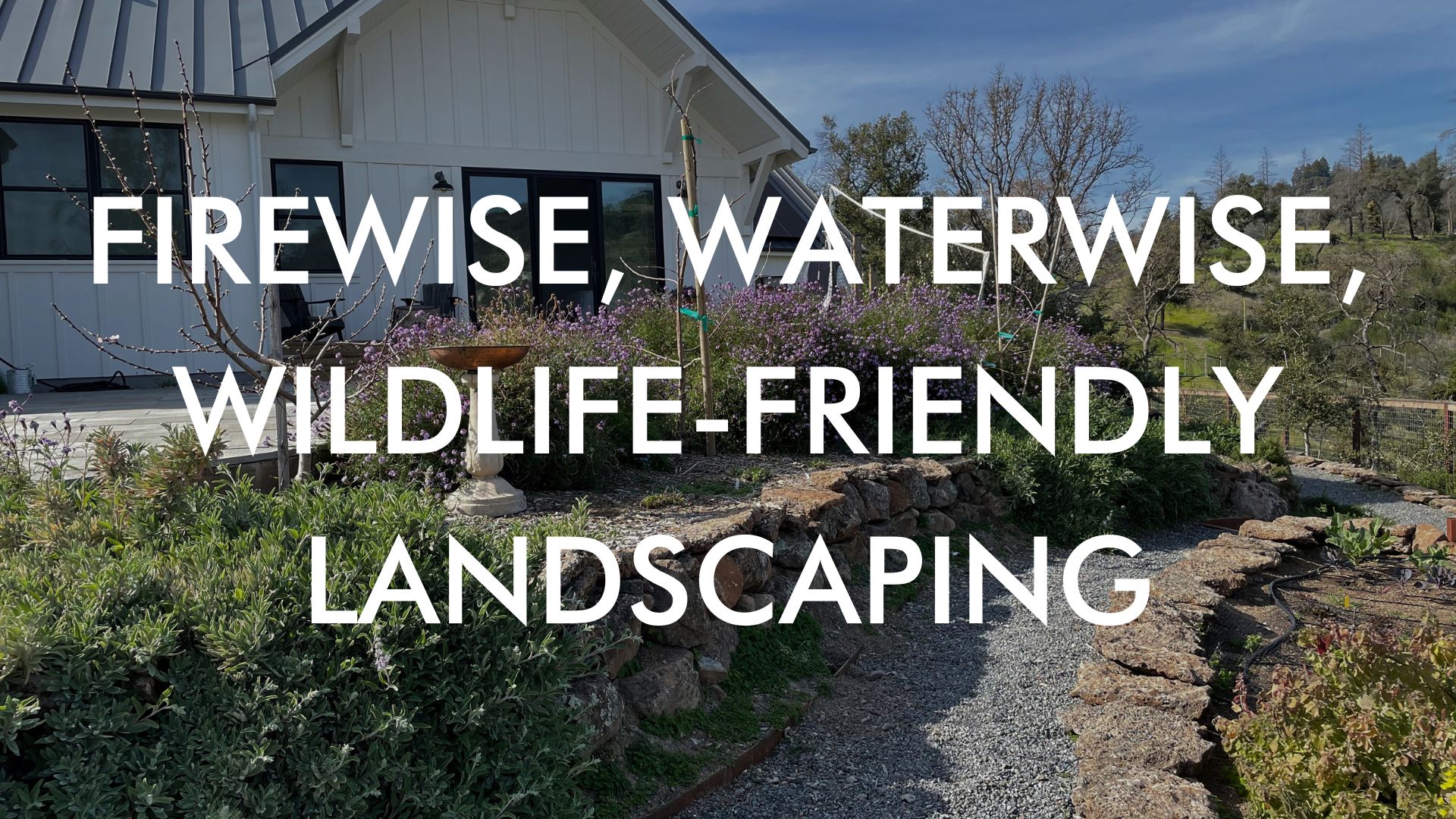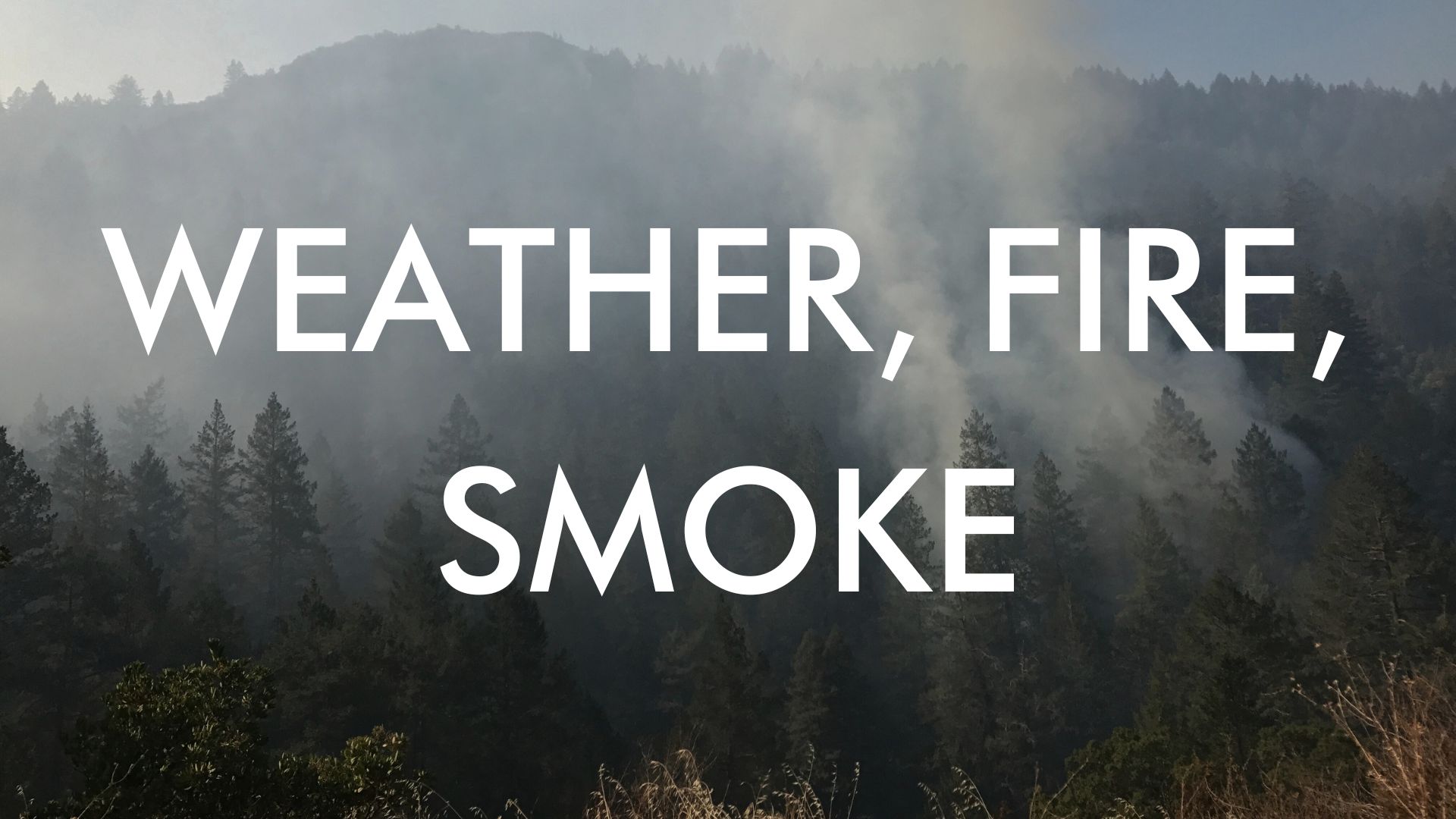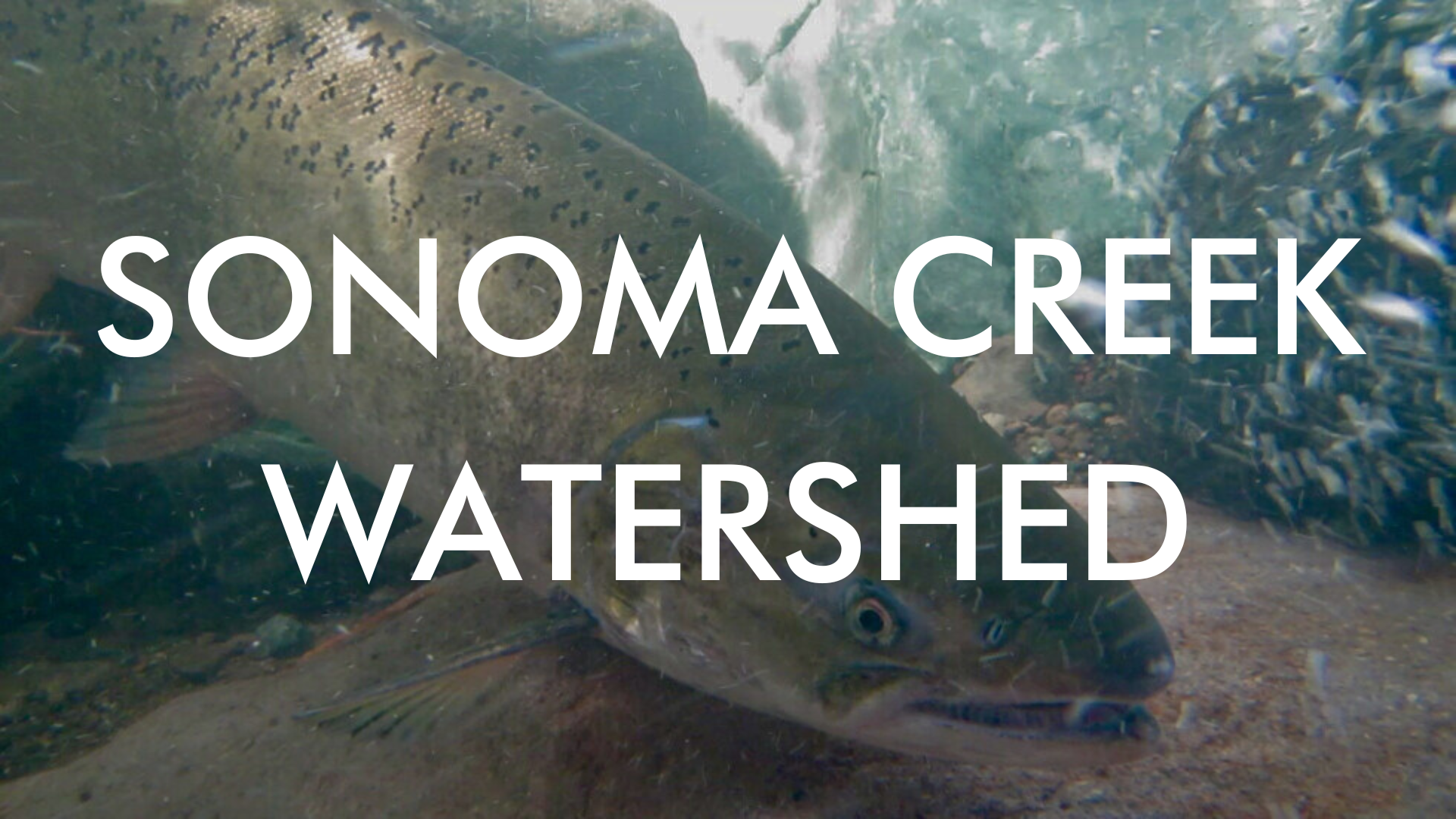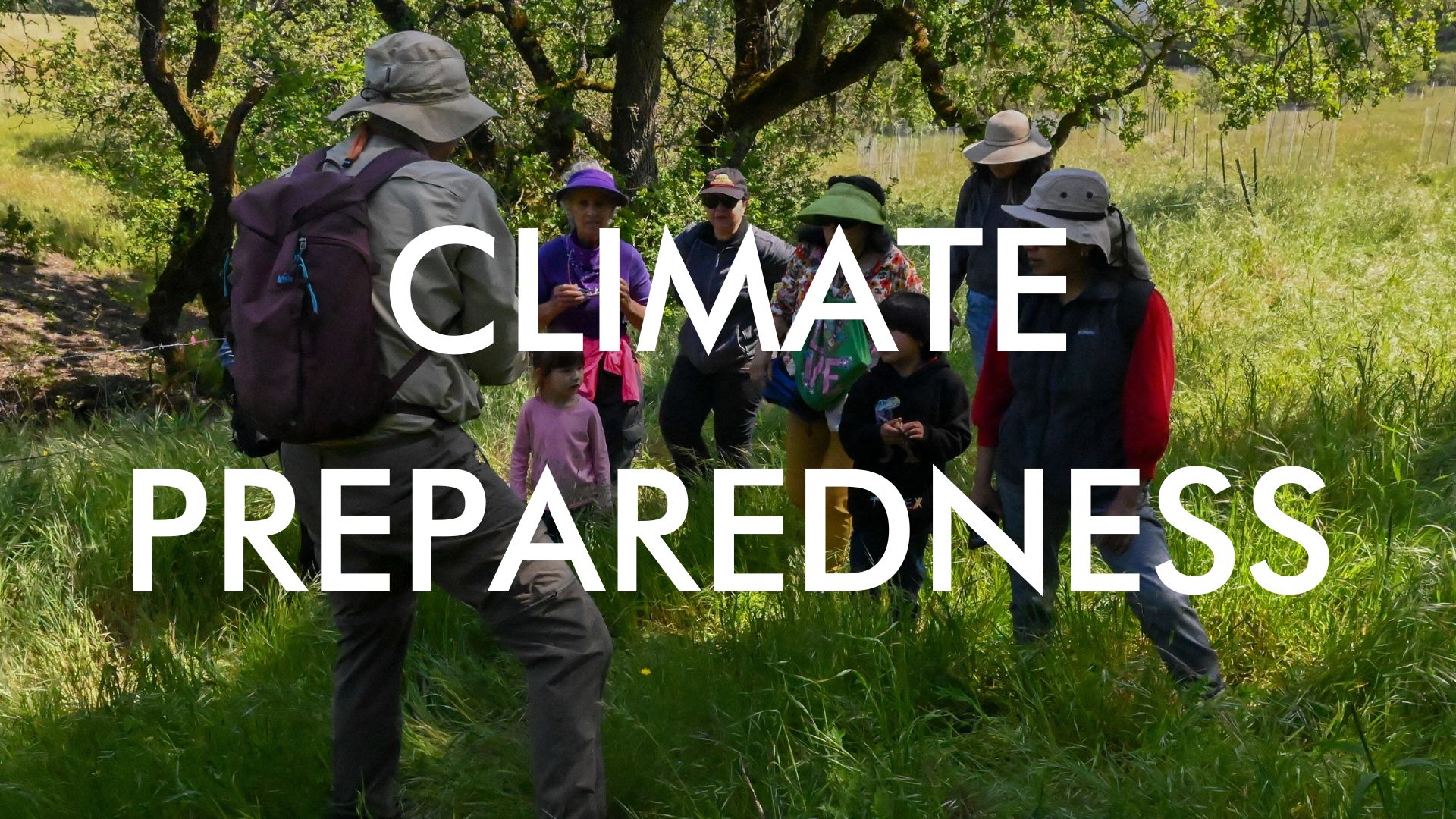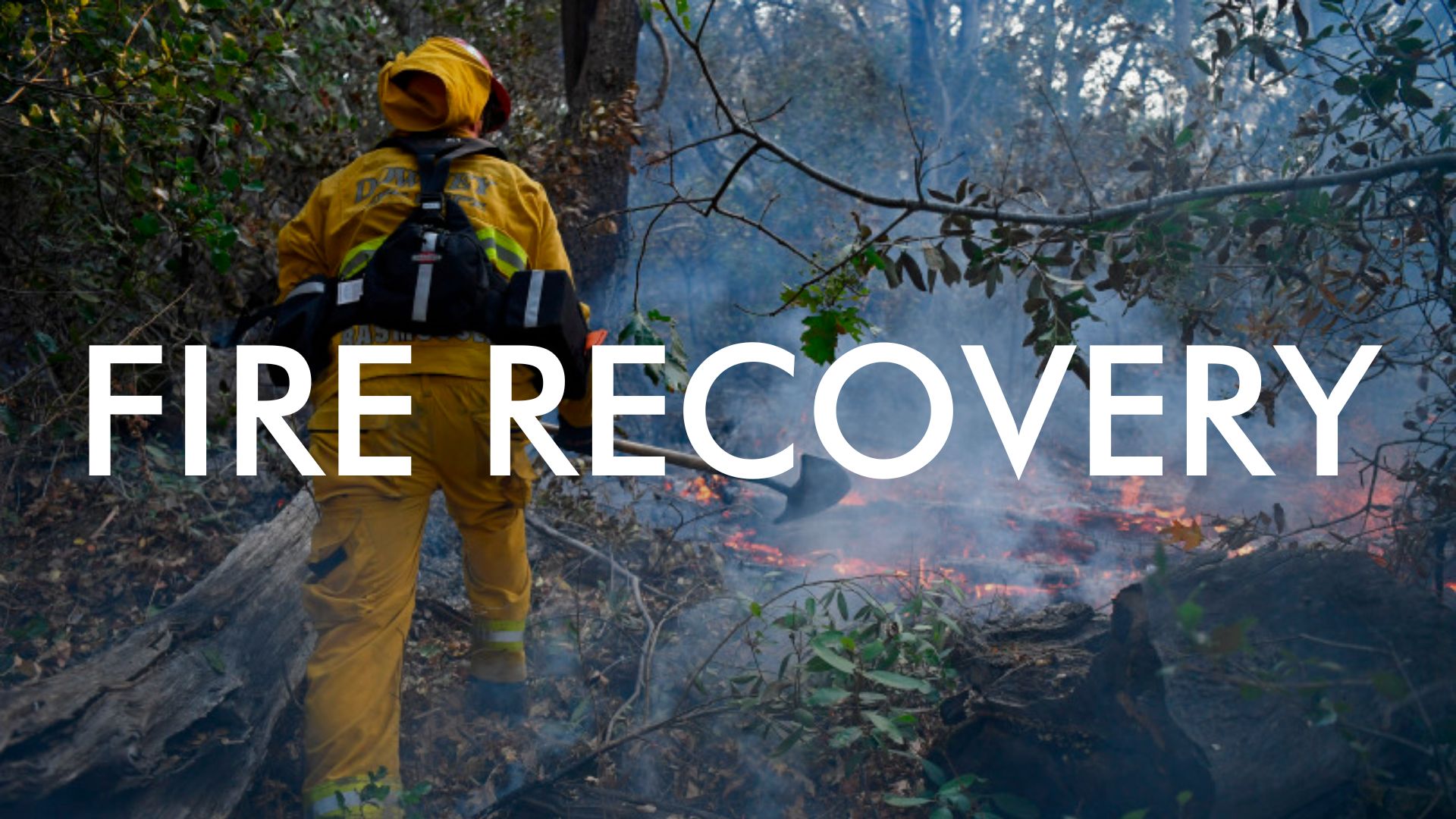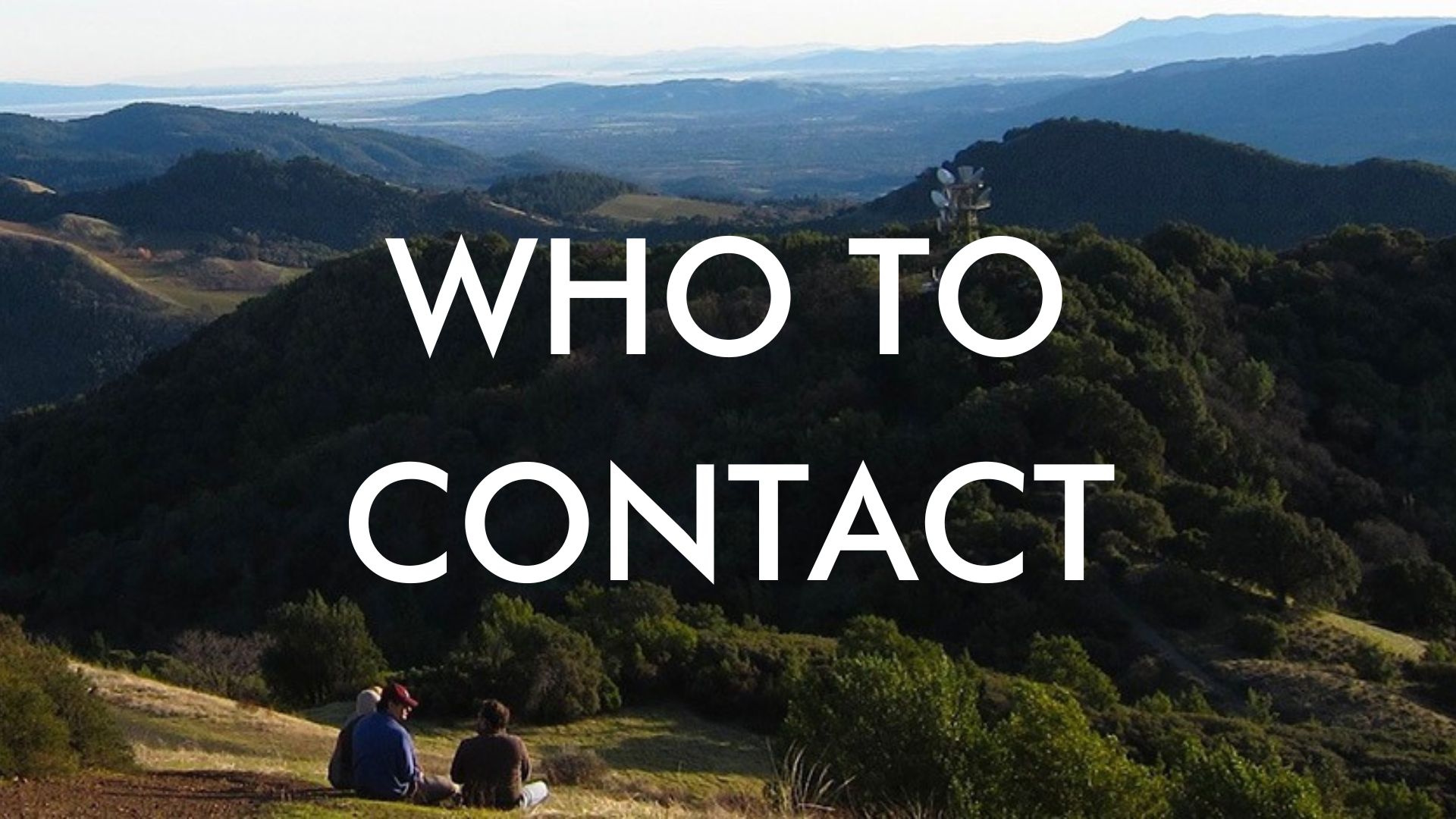Sonoma Ecology Center Resource Hub
Firewise, Waterwise, Wildlife-Friendly Landscaping Resources
Firewise, Waterwise, Wildlife-Friendly Landscaping
Resilient Landscapes Coalition: A coalition that Sonoma Ecology Center is part of. A great resource for defensible space information, events on defensible space, and fire-wise and water-wise landscaping.
Weather, Fire, and Smoke, and Power Shut Offs Resources
General Emergency Resources
Everbridge Nixle: Sign up to receive alerts of critical events from your local agencies and businesses.
Fire
- Watch Duty: A real-time map of wildfires and firefighting efforts, crowdsourced from active and retired wildland firefighters, dispatchers, first responders, and reporters
- CalFire Incidents Main Page
- ESRI Wildfires map: A well displayed, but not always current, map.
- Backcountry Mapping Evolved: A broad array of geographic information with selectable data, including active and past fire areas
Air Quality
- Purple Air Map: Air quality in fine detail.
- Airnow Air Quality Forecast
- National Weather Service Air Quality Forecast Map
Weather and Wind
- National Weather Service Forecast: note weather hazard section if applicable at top.
- National Weather Service Weather Forecast Discussion
- Local Newspaper’s Projected Wind Gust Map
Mountaintop/Hillside Webcams
Power Shutoff information
Sonoma Creek Watershed Resources
Sonoma Creek Watershed Resources
Upper Sonoma Creek Restoration Vision – A thorough analysis, report and demonstration project proposal for improving the upper reaches of Sonoma Creek. This vision booklet featuring beautiful maps and diagrams was developed to improve spawning conditions for adult Steelhead.
An Introduction to the Historical Ecology of the Sonoma Creek Watershed – This publication is intended as an introduction to how historical ecology can help local residents and resource managers understand current conditions and develop strategies for environmental recovery in the Sonoma Creek watershed.
What is a Watershed? – Downloadable educational handout (pdf, front and back) explaining the meaning and importance of a watershed, with details about our own Sonoma Creek Watershed. We use it when we teach in Sonoma Valley schools.
Southern Sonoma County Resource Conservation District’s Creek Care Guide
Sonoma Valley Historical Hydrology Mapping Project
Sonoma Valley Groundwater Recharge Potential Mapping Project
Climate Preparedness & Resiliency Resources
Climate change calls for two types of responses: preparing for its impacts, and reducing greenhouse gas emissions. Sonoma Ecology Center has focused primarily on preparedness, using science and outreach to better understand climate hazards and to spur action.
To get this done, Sonoma Ecology Center cofounded the North Bay Climate Adaptation Initiative (NBCAI) in 2009. NBCAI is a leader in Sonoma County on preparing our region for the inescapable effects of climate change.
Understanding Climate Hazards and Our Work
Sonoma Valley’s chief climate hazards are drought, flood, extreme heat, and wildfire, which is projected to increase dramatically over the next 50 years. Meanwhile, the Valley is already seeing groundwater decline unlike anywhere else in the North Bay.
Sonoma Ecology Center has worked to inform the public on local climate hazards in the following ways:
- A detailed report by NBCAI prepared for the Sonoma County Regional Climate Protection Authority, “Climate Ready Sonoma County: Climate Hazards and Vulnerabilities” (PDF)
- Promoting interactive online tools to help us better understand climate risks (see below for full list)
- Delivering the message directly through presentations and videos.
- Organizing public forums, such as this 2015 all-day forum held at Sonoma State University: sonomacountyadaptation.org/climate/presentations
Although Sonoma Valley has always had the periodic problems of drought, flood, extreme heat, and wildfire, climate change is making them worse. However, with concerted action by the community, we can reduce the harm they will cause.
How can I promote climate resiliency where I am?
What can Sonoma Valley’s residents and businesses do to tackle these challenges? A good climate response involves two steps: climate preparedness, for example, making preparations for a changing climate, and doing what we can to reduce emissions and improve our efficiency.
Some straightforward actions that all residents can take are:
- Walk, bike, travel by mass transit, or use an electric vehicle
- Live close to your work, school, stores, and other basic necessities
- Buy and eat locally
- Use less water
- Vote with climate change policies in mind
For certain Sonoma Valley residents, we’ve developed more specific actions that take into account where you live, how you get your water, your role in the community, and other factors:
- If you use a water well, join this well monitoring network so we can better understand how our complex groundwater basin works.
- If you own or live on a streamside property, maintain wider buffers alongside streams and wetlands in order to make room for future floods.
- If you own or live on a property with forests in Sonoma Valley, use thinning and controlled burns to reduce flammability and increase biodiversity.
- If you’re a business owner, position your business to protect employees and facilities from extreme events, create a resilient low-emissions supply chain, and try to provide products and services that will help the community prepare and adapt.
- If you work in government, foster climate resilience by coordinating incentives and funding, collaborating with other agencies, subsidizing sustainable agriculture, creating wise land management plans and development codes, quantifying the many benefits of resilience investments, protecting and expanding our natural water systems, and supporting the population’s health, housing and financial security.
- If you’re a farmer, increase multiple-crop operations, use carbon-sequestering techniques and tools (such as biochar), support a more diverse agricultural sector, and conserve and reuse water at all scales.
- If you are involved with a school, nonprofit, church group, club or similar organization, or if you’re just someone who likes to stay connected with your neighbors, keep tabs on the community’s climate change preparedness and remain active and engaged locally.
For more on specific actions that individuals and businesses can take, see the Future-Proofing: A Roadmap for Climate Resilience in Sonoma County brochure or the Roadmap for Climate Resilience in Sonoma County, both developed by NBCAI. Also see these helpful NBCAI fact sheets.
In all cases, an important course of action for residents and businesses involves good groundwater management. For more on groundwater management in Sonoma County, visit the county’s Sustainable Groundwater Management Act page or Sonoma County Water Agency’s Groundwater Management Program page.
Finally, remain politically involved in ways particular to your community. For example, Sonoma County residents should tell their city leaders or supervisor to adopt Climate Action 2020 or to at least implement that plan’s emissions measures. CA2020 already has been adopted by the City of Sonoma – but we should all demand that other cities, and the county, follow suit.
Climate hazards/risk tools
Here are some interactive online tools for understanding climate hazards:
- PREP: Sonoma County’s Climate Resilience Dashboard
- The Climate Commons: Extensive searchable library of climate adaptation resources, including articles, watershed analyses, BCM variables (available as GIS downloads), and a comparison of many more climate tools
- Climate Ready North Bay: Customized analyses based on climate-related watershed management questions from North Bay users
- Conservation Lands Network Explorer: Creates maps using different climate futures and time periods to track BCM variables along with vegetation, protected land status, and conservation value
- SF Bay Area Watershed Analyst: Graphs, tables, and seasonal water balance diagrams for any Bay Area watershed using different climate futures
- CalWeedMapper: Interactive mapping and reports on invasive plant trends based on climate suitability and proximity to infestations
- Vegetation modeling: Bar graphs showing changes in vegetation types using different climate futures
Sonoma Valley & North Bay Fire Recovery Resources
Wildfires have created serious challenges for North Bay residents, many of whom are concerned about soil erosion, toxic runoff, and the health of fire-ravaged landscapes. Read on for insights and advice on these issues, presented by our staff of expert ecologists.
All residents, especially property owners and caretakers, are encouraged to follow the guidelines below in order to ensure the continued health of Sonoma Valley and the North Bay. By working together, we are always able to rebuild—and to make our home more beautiful, healthy and sustainable than before.
Basics on the post-fire landscape
In most cases, once toxic ash and debris from human-made structures is removed from a burn site, the land will heal itself quickly. In some cases, and on most of any given property, the best thing to do is nothing—just stand back and let the land heal.
Look for wildflowers to grow in great profusion after fires, including the “fire followers” that only appear after fire. Also watch for rare species such as spotted owls, which take advantage of burned landscapes.
How to care for burned trees
This guide from the University of California provides specifics on how to assess and respond to damage to burned oak trees. Consult with an arborist if you think a large tree poses a danger and must be removed. Otherwise leave them be.
Post-fire erosion control
Other tips for keeping sediment out of waterways include: clear storm drains and culverts of debris to prevent flooding, redirecting sheet water into storm drains (and away from waterways); clear out gutters and ditches; repair fire breaks so they do not channel runoff but blend evenly with the slope of the land; minimize foot and equipment traffic as much as possible.
Ideally, stormwater should be allowed to sink into the soil and recharge our aquifers. More on stormwater management is available in this landowner’s guide from the Sonoma Resource Conservation District: Slow It. Spread It. Sink It!
Over broad areas of burned land, you can spread weed-free straw (rice straw is the safest) in a very thin layer to soften the impact of raindrops. Evidence is mixed on the effectiveness of straw. Don’t use whole bales, which block the light from reaching the ground, or create clumps. To avoid planting fire-prone weeds, be very careful to use only certified weed-free straw.
Post-fire reseeding
Still, there are some cases where careful reseeding is recommended. Here are guidelines for knowing when and how reseeding should occur:
- Sites where seeding might be needed tend to be sloped areas that burnt very hot, leaving behind a white ash on the ground. Flat areas that burnt at lower temperatures, leaving behind a black ash on the ground, generally do not need any seed or erosion control measures. If practical, a thin straw mulch will help hold soil in place (see above).
- Never put fertilizer on a burn site. Fertilizer will only enhance the growth of weeds, allowing them to outcompete native plants, and build up more flammable materials when the non-native annual grasses dry out in the summer.
- If seeding is necessary, use only sterile grass seed (wheat) or short-lived perennial native grass seed mixes sold for erosion control, such as Holdfast Native Blend available at LeBallister’s Seed & Fertilizer in Santa Rosa.
- Adjust seeding rate according to the severity of the burn. In white ash areas, use at the full recommended rate, e.g. 10 lbs/acre. On black ash, either do not seed at all or seed at a reduced rate (e.g. 4 lbs/acre).
- Seeding on gentle slopes of 3:1 or less can benefit from straw with a “tackifier” to help hold the seed and straw in place. Straw provides moisture retention that will improve germination and reduce seed predation by birds and rodents. Seed just prior to rain, to reduce seed predation.
- Steeper slopes greater than 3:1 will need tackifier and straw, or a biodegradable erosion control fabric, to keep seed and soil from washing downslope. Consult with an erosion control specialist on steep slopes.
- Continue to monitor burn sites as the season progresses. Seedlings should start to emerge after the first few rains. If not, you may need to seed or reseed bare areas and possibly add erosion control measures if rills form or other soil movement is observed.
- No two sites are the same, and long-term monitoring with adaptive management is necessary to ensure success of seeding and erosion control efforts. Observe and adjust.
Fostering wildlife recovery post-fire
- Put out low, shallow containers of water for animals to drink.
- Do not remove natural woody debris from your property, but instead make piles of this clean organic material in quiet corners of your property to provide habitat for smaller creatures like quail, lizards and frogs.
- Use native plant species or those known to mimic them. Local plant lists are here.
- Put up nest boxes.
- Leave burned branches, shrubs and trees in place unless they pose a danger.
- Keep domestic carnivores (dogs, cats) indoors and on leash.
- Where possible, remove fences to give animals more room to roam.
Post- fire toxic runoff
Although burned vegetation is non-toxic, burnt human-made structures leave behind toxins including sulfates, nitrates, asbestos, and heavy metals. Click here for a map of local structures that burned. This toxic ash can wash into our waterways during heavy rains, so keeping the ash and debris in place until it can be hauled away has been a top priority.
Agencies, nonprofits, and residents worked extensively in past fires to contain and remove toxic ash and debris before the rains came. Authorities then followed procedures to remove most toxic ash and debris from burned sites with structures and vehicles.
Residents can still help contain remaining burned structures that have not yet been cleaned up, and by following erosion control measures as noted in the section above.
If using wattles to contain toxins, they should be placed 1) around burned structures and vehicles, containing the white ash area, 2) at the top of stream banks, even on small channels, and 3) around inlets of storm drains and road culverts. Wattle effectiveness is directly tied to how level they are. As runoff water hits the wattle, it needs to go through the wattle, not along it. Use a level so that the wattle line follows the land’s contours.
Wattles are still generally available at hardware stores and at some county locations.
If wattles are unavailable, use fallen branches, small berms, sandbags, check dams or staked boards – installed in the ways described above for wattles – in order to contain toxic ash.
Sonoma Ecology Center wildfire recovery work
Sonoma Ecology Center was established in 1990 to help create a future where people, land, water and wildlife thrive. After more than a quarter century of working with our community to identify and lead actions that achieve and sustain ecological health in Sonoma Valley, we are well qualified to guide fire recovery efforts here.
As Sonoma Valley’s local “second responders,” we’ve been hard at work helping the community, and the environment, heal from wildfires that destroyed hundreds of structures and burned more than a quarter of the land in Sonoma Valley in 2017.
We’ve broken our fire response into three main components: education, active response, and prevention.
Education
Knowledge is power, and by sharing knowledge on Sonoma Valley’s fire history and ecology – and the way these things impact local wildlife and watershed health – we’re helping our youth and adults build a more fire-resilient community.
Active Response
We are helping coordinate fire response with multiple agencies and NGOs, resulting in the fastest possible assessment of burn intensity, erosion potential, water quality, stream protection and site remediation. Our maps, for example, have been crucial for getting information to the public. Our Sonoma Biochar Initiative is supplying and testing biochar for soil remediation on home sites and agricultural land.
Our Restoration team provides on-the-ground services and knowledge unparalleled in Sonoma Valley when it comes to ecologically sensitive land repair and cleanup, replanting native species grown in our nursery at Sonoma Garden Park, and restoring the cherished open spaces that we manage: Sugarloaf Ridge State Park, Van Hoosear Wildflower Preserve, Nathanson Creek Preserve and Montini Open Space Preserve.
Prevention
Wildfire has always been here and it will return – and when it does, how can we make sure our community is fire-resilient? We believe Sonoma Valley can rebuild with fire ecology in mind, so we’re joining the conversation at every level – including multi-agency meetings at the county level – to make sure local leaders have the information they need to make good decisions on the future of our Valley. In 2017, the first Sustainable Sonoma Council meeting convened nearly 20 wide-ranging interest groups to share post-fire experiences and priorities with one another. With this meeting, we enabled community leaders to identify shared goals that we can only achieve together. The group has now become Sonoma Valley Collaborative.
Here are some of the assets our team is able to put toward rebuilding a Sonoma Valley where people, land, water and wildlife thrive:
- Decades of experience in erosion control, ecological restoration, salmonid habitat protection and enhancement, stormwater management, and slope stabilization
- Detailed knowledge of Sonoma Valley streams and roads.
- Working relationships with local, state, and federal agencies tasked with improving streams, stream crossings, culverts, ditches, etc., and with the local leaders who oversee their efforts
- Connections with local landowners, particularly along streams (dozens have already reached out to us)
- Large quantities of high-quality biochar for use in wattles and as soil remediation
- Skilled labor under experienced leadership, and the ability to marshal volunteer labor through our highly capable Volunteer Coordinator
- Heavy duty trucks, power tools, hand tools and other equipment
To learn more about what Sonoma Ecology Center can do to help you prepare for wildfire or support fire recovery efforts, contact us at restoration@sonomaecologycenter.org.
More fire recovery resources
Ways to Help
- Sonoma County Recovers: Sign up to donate and/or volunteer.
- Sonoma County Resilience Fund: Donate to the Resilience Fund.
- Sonoma Valley Ecological Relief Fund: https://www.sonomaecologycenter.org/sonoma-valley-fires-fund/
Environmental
- USDA Wildfire Preparation and Recovery Resources
- Napa Resource Conservation District Wildfire Recovery
- Sonoma Resource Conservation District Fire Mitigation and Post-Fire Recovery
- Las Pilitas Nursery Post Fire Information
- University of California Agriculture and Natural Resources Burned Oaks: Which Ones Will Survive? PDF.
- Marine Resource Conservation District A Handbook for Small-Scale Erosion Control PDF
- Press Democrat Article First aid for Sonoma County’s fire-damaged soil
Post-Fire Safety and Clean-up
Looking Ahead
Who-to-contact Guide
Click on the sections below to find answers to your questions about resources available for help on all your ecological questions and issues in Sonoma Valley.
Animals including Fish & Insects, and Animal Control
Animal Control & Rescue
City of Sonoma Animal Control – within city limits – 707.996.3602
Sonoma County Animal Care and Control – outside city limits – 707.565.7100
Sonoma County Wildlife Rescue: I found an animal, now what?
To report poaching, contact the CA Department of Fish and Wildlife
Specific Animal Information
Bats
- Bat Conservation International is the source for all your information about bats, bat houses, white nose syndrome, bats in bridges, injured bats, and more
- If you find a bat in distress in the Bay Area, call the BCCC hotline at 408-647-7BAT (408-647-7228)
Bees
- Report a swarm to Sonoma County Beekeepers
Bird Rescue
- Sonoma County Bird Rescue provides information for bird rescue within Sonoma County, including baby birds, bird rehabilitation, nest boxes, keeping birds healthy and more
Bird Conservation & Observation
- Sonoma Birding
- Madrone Audubon Society (North Bay)
- Petaluma Wetland Alliance (a committee of Madrone Audobon Society)
- Point Blue (Formerly Point Reyes Bird Observatory) (North Bay)
- Redwood Region Ornithological Society (North Bay)
- Golden Gate Raptor Observatory (National Parks Service)
- Audubon Canyon Ranch (North Bay)
Bird Health and Feeding
- Attracting Birds – Cornell Lab of Ornithology
- Backyard Feeding – US Fish and Wildlife Service and Cornell Lab of Ornithology
- Feeding Birds – National Audubon Society
- Healthy Bird Feeding – Wild Birds Unlimited
- Feeder Maintenance and Hygiene – National Audubon Society
Deer
- Fawn Rescue is a local (Kenwood) rescue center for injured and orphaned deer.
Fish
- Fishing in the Region: CA Department of Fish and Wildlife
- Report a Poacher or Polluter at CalTIP 1 (888) DFG-CALTIP — Call 24 hours a day, seven days a week
- Other Questions? Email a Fish and Game Warden
Mosquitos
Reptiles
Wildlife Sightings
If you have an interesting wildlife sighting, email us! Be sure to include location, time, weather, and other information that can help us continue to monitor wildlife here. Photos are great, too!
More Information
Threats to Wildlife – CA Dept of Fish and Wildlife
Federally listed (threatened and endangered) animals and plants – US Fish and Wildlife Service
Native Plant Restoration and Invasive Plant Control
Native Plant Restoration & Invasive Plant Control
- Sonoma Ecology Center’s Restoration Program provides a vegetation management program including streamside and landscape invasive plant removal and native plant restoration. For more information contact Restoration Team at 707-996-0712, ext. 116 or at restoration@sonomaecologycenter.org.
- California Invasive Plant Council (CalIPPC) provides information about invasive species and attractive alternatives for your garden
- Team Arundo del Norte is a forum dedicated to the contraol of Arundo donax (giant reed) where it threatens rivers, creeks and wetlands in Central and Northern California. Learn how to control one of California’s most aggressive streamside plant pests.
Native Plant Sources
- Sonoma Ecology Center operates a Native Plant Nursery at Sonoma Garden Park. In addition, we offer streamside and landscape native plant consultation and restoration services. Contact the Restoration Team at 707-996-0712, ext. 116 for further information.
- California Native Plant Society – Milo Baker Chapter is a statewide organization whose goals are to increase understanding and appreciation of California’s native plants
- CalFlora Nursery specializes in California native plants and habitat gardening since 1991.
Pesticide Use & Issues
See our Pollution & Hazards section.
Hazards, Nuisance, Pollution, Proper Disposal
Emergencies
- To report a health hazard or nuisance – Sonoma County Environmental Health Division
- For electrical or gas emergencies or hazardous situations – contact PG&E and please call 911 or 800.743.5000
- Sonoma County Road Closures & Restrictions – County of Sonoma
Noise Complaints & Issues
- Sonoma County Noise Complaint Hotline – 707.544.4787
- Acoustical Consultants – Bay Area Noise Control
Pesticide Use & Problems
- General pesticide information – Sonoma County Agricultural Commissioner
- To report a problem or pesticide abuse – CA Department of Pesticide Regulation
- Pesticide Illness Reporting – CA Office of Environmental Health Hazard Assessment
Sewage Overflow
- To report a sewage overflow in Sonoma County, call Sonoma County Department of Emergency Services Public Hotline at 707.565.3856
- To report a blockage or spill in Sonoma Valley, call the Sonoma Valley County Sanitation District at 707.523.1070 (24 hours)
Waste Disposal Information
- Hazardous Waste Disposal – Sonoma County Waste Management
- Recycling – Sonoma County Waste Management
Water Pollution
- To report water polluters – CA Department of Fish and Wildlife

